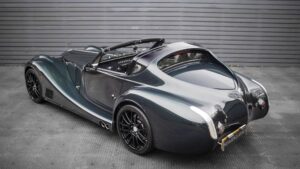Morgan Aero 8: road car buying guide
Robert Ladbrook takes a look at the Aero 8, the cross-eyed curio that proved Morgan was more than a company stuck in the past

Mention Morgan cars to your mates and I guarantee that you’ll be met with that most predictable of retorts: “Aren’t they all made of wood? Watch out for termites…” No matter how stylishly retro or affordable Morgans were, approaching the 21st century its manufacturing technique had come to define the brand as stuck in the past.
Morgan used to hold its own on road and track. At Le Mans in 1962 a factory-run Plus 4 Super Sports driven by Chris Lawrence and Richard Shepherd-Barron topped the 2-litre GT class, and that success could have come a year earlier if the ACO had not rejected the car for “looking too oldfashioned”. Morgans divided opinion even then.
In the mid-1990s, and approaching its centenary year, company head Charles Morgan decided it was time to prove that his family business could indeed cut it in the modern age and began work on the company’s first all-new design since 1964’s Plus Four Plus.
Morgan started with a new monocoque chassis, made entirely from aluminium, as opposed to the traditional steel chassis and wooden tub that had been the firm’s mainstay.
To test the new platform, a chassis was clothed with Plus 8 bodywork and entered in the GT2 class of the 1995 Global BPR sports car series. While the car stood little chance against Porsches, the two-year programme proved the capabilities of the chassis, and the fragility of the ageing Rover V8 engine.
Keen to make the most of the design, Morgan set about transforming it into what would become the company’s first supercar – the Aero 8, which was revealed in 2000.
The chassis featured bonded aluminium elements, with ash wood sandwiched between the solid frame and the lightweight bodywork as a nod to Morgan’s history, but also a raft of clever innovations, like all-independent suspension with inboard shock absorbers and double wishbones all round.
Morgan also sought a partnership with BMW, which provided a 4.4-litre V8 engine. Then came the bodywork. The sweeping curves were a huge departure from traditional Morgan styling. While it did retain those familiar 1930s-style sweeps and family grille, the overall aesthetic took a bit of getting used to. Things weren’t helped by the cross-eyed lamps from a Volkswagen Beetle, swapped to suit the shape.
Early Aero 8s could hit 62mph in just 4.8sec and go on to nudge 160mph, proving the model’s sporting capabilities. Morgan also prepared one for racing, returning to Le Mans in 2002 on the 40th anniversary of the factory’s class win. The car failed to finish after rattling its axle to pieces and enduring engine issues.
Regardless, the Plus 8 set a new tone for the company. Four main iterations were made, as well as some stunning special editions, such as the AeroMax – designed by student Matt Humphries, earning him a job at Morgan on graduation – and the beautiful Aero Supersports, with its targa roof and boat-style tail.
One for sale

 2010 Aero 8 Supersports
2010 Aero 8 Supersports
One of just 180 special editions, this is the most beautiful of the lot.
£POA
Morgan Aero 8 statistics
- Price new £55,000
- Price now £60,000-£130,000
- Engine 4.4-litre BMW V8
- Rivals Porsche 911 GT2, Lamborghini Murciélago, TVR Tuscan
- Verdict Like it or loathe it, it was a significant Morgan milestone that launched the firm into its next century
